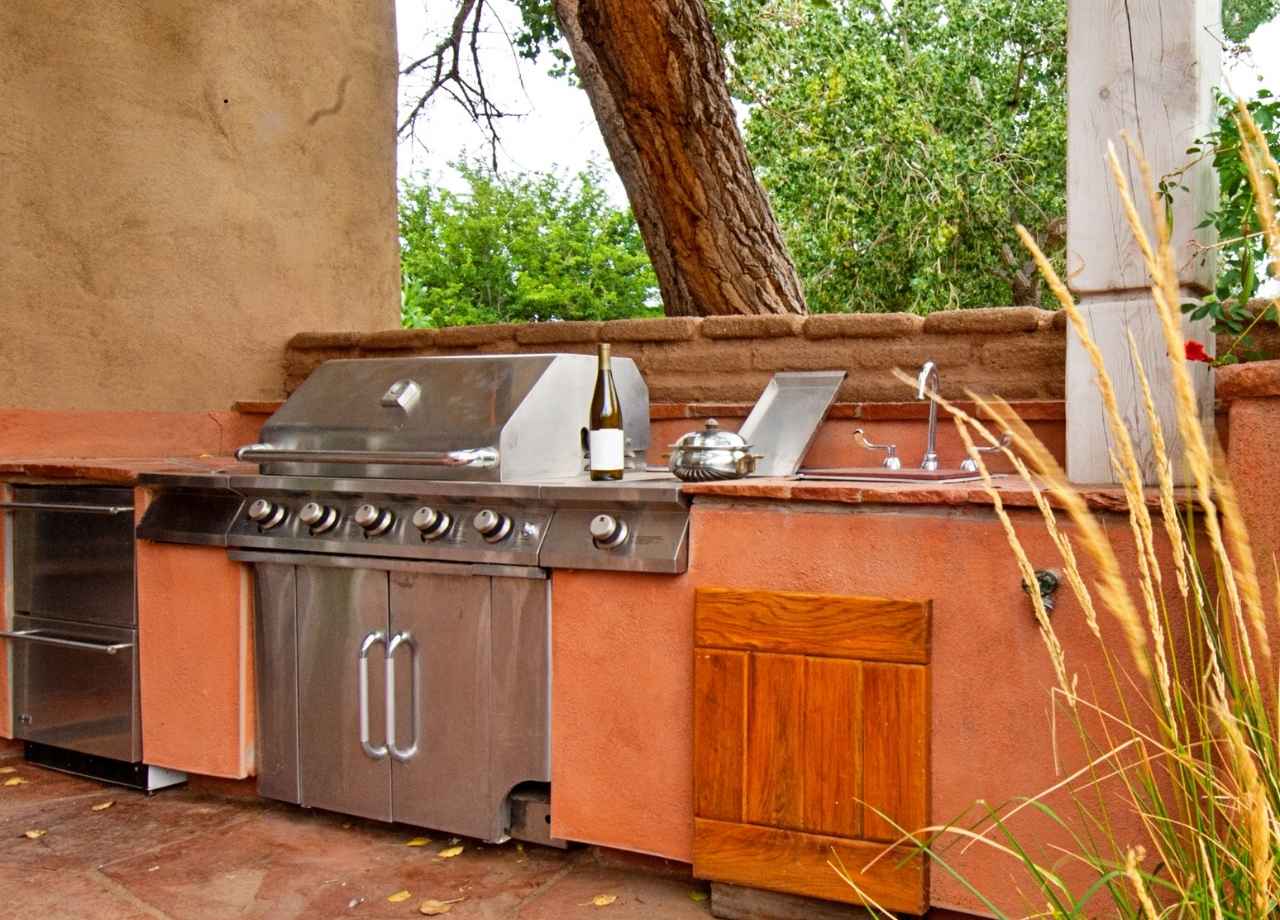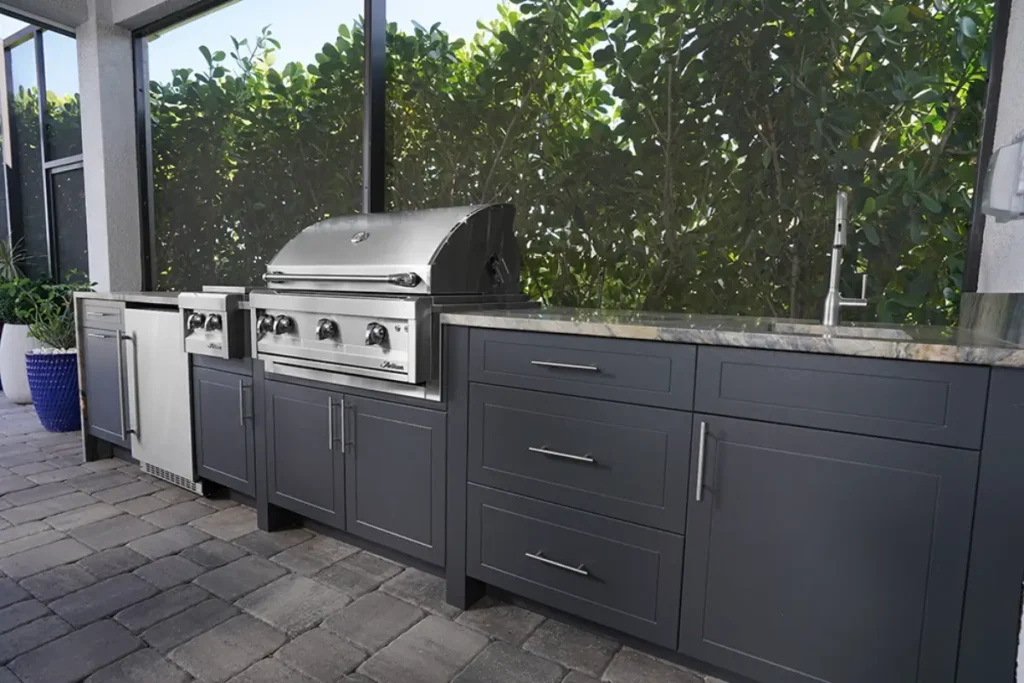
Comparing PVC Outdoor Kitchen Cabinets to Stainless Steel and Wood
Outdoor kitchens are no longer an add-on luxury. They’re a central part of how homeowners enjoy their backyard space in places like Jacksonville, where the climate demands materials that hold up against heat, humidity, salt air, and sudden storms. One of the biggest decisions when building an outdoor kitchen comes down to cabinetry. The right cabinets aren’t just about looks—they dictate how well your kitchen ages, how much maintenance you’ll need, and how much you can actually enjoy the space over time.
At Calico Outdoors, we specialize in high-performance outdoor kitchen systems designed specifically for the challenges of Florida living. We work with materials that make sense not just on paper, but in real-world conditions. Let’s break down how PVC outdoor kitchen cabinets compare to stainless steel and wood across the most important categories.
Table of Contents
Durability in Harsh Outdoor Conditions
PVC (polyvinyl chloride) cabinets are made to handle extreme environments. They’re non-porous, waterproof, and impervious to rot, mold, or mildew. This matters in places where afternoon downpours and high humidity are the norm. PVC doesn’t absorb moisture like wood or corrode like steel, which makes it one of the most resilient choices for year-round exposure.
Stainless steel, especially marine-grade 316, is known for being corrosion-resistant, but it’s not entirely immune to rust, especially in coastal areas with salt air. If not maintained properly, or if the wrong grade is used, staining and surface pitting can appear over time. Heat can also make stainless steel hot to the touch in direct sunlight, which isn’t ideal if you’re using your kitchen during the heat of the day.
Wood, depending on the species, brings some natural resistance to weather, but it’s always going to be vulnerable to moisture. Even pressure-treated or sealed hardwoods eventually show signs of wear, especially in humid climates. Splitting, warping, and fading are common, and constant upkeep is required to preserve the look and structural integrity.
Maintenance and Longevity
PVC cabinets require almost no upkeep beyond occasional cleaning. They don’t need sealing, staining, or repainting, and there’s no risk of termites or pests. The material stays stable over time, even in direct sun and heavy rain.
Stainless steel does best when it’s cleaned regularly to remove salt and debris, especially if you’re near the coast. Fingerprints, smudges, and scratches are common cosmetic issues, and maintaining its shine can be time-consuming without the right cleaners.
Wood cabinets need the most attention. They often require seasonal sealing or staining, especially if you want to prevent graying or mold buildup. And no matter how much care you give them, wood will gradually break down when exposed to the elements long enough.
Design Flexibility and Visual Appeal
PVC has come a long way in terms of appearance. It can be manufactured in a wide range of colors and textures, including woodgrain finishes that mimic natural wood without the maintenance. Customizations are easy, and the clean lines work well with both modern and traditional outdoor kitchen styles.
Stainless steel has a sleek, professional look that works well in ultra-modern designs. It pairs well with stone and concrete but can appear cold or industrial in some settings. Color customization is limited unless powder coating is used, which adds cost and introduces another layer that can chip or scratch over time.

Wood is timeless and warm. It brings a natural, handcrafted feel that many people love. But outdoor conditions rarely let it stay looking that way without a significant amount of effort. The visual appeal can fade fast when exposed to UV rays, rain, and insects.
Installation and Customization
PVC cabinets are lightweight compared to stainless steel and can be installed more quickly. They can also be cut and assembled on site if necessary, allowing for custom configurations that suit unusual layouts or design preferences. Because the material is consistent and factory-finished, the final result is predictable and clean.
Stainless steel cabinets are often pre-fabricated, which can limit customization unless you go the custom fabrication route—a significantly more expensive and time-consuming process. The weight of steel also means installation is more involved, and the risk of denting during transit or handling is higher.
Wood cabinets offer flexibility in terms of carpentry, but that also means longer build times and more variables depending on the skill of the installer. Changes on site can be made, but they often require tools and techniques that increase the overall labor involved.
Cost Comparison Over Time
Initial material costs vary, but when factoring in maintenance, repairs, and longevity, PVC often comes out ahead over the long haul. It requires fewer resources to maintain and rarely needs replacing or refinishing.
Stainless steel carries a premium upfront, particularly when using marine-grade material. Add to that the potential for cosmetic damage and the cost of regular maintenance, and the lifetime cost can grow quickly.
Wood can seem affordable at first, especially with softwoods or pressure-treated options. But long-term costs add up with ongoing sealing, repairs, and possible replacements due to warping or insect damage.
Environmental and Safety Considerations
PVC is often scrutinized for its manufacturing process, but once installed, it’s inert and safe. High-quality PVC cabinetry is free of formaldehyde and other VOCs, which makes it a safe choice for outdoor family spaces. Recyclability depends on the specific blend and whether facilities exist to process it in your area.
Stainless steel is recyclable and has a long lifespan, but it requires significant energy to produce. It’s also a heat conductor, which can be a safety concern in full sun.
Wood is biodegradable, but treatments and sealers often include chemicals that aren’t environmentally friendly. Untreated wood breaks down quickly, and treated wood raises concerns for surrounding plant life and groundwater over time.
Final Thoughts
Choosing cabinetry for an outdoor kitchen in a climate like Jacksonville’s means thinking beyond style. PVC offers a strong balance of durability, low maintenance, and design flexibility. It doesn’t rot, warp, rust, or require seasonal care. Stainless steel is tough, but not infallible. Wood is beautiful, but high-maintenance.
If your goal is a backyard kitchen that looks great, performs year-round, and gives you more time to relax than to repair, PVC cabinets deserve serious consideration. For those ready to build an outdoor kitchen that holds up to Florida’s unique challenges, Calico Outdoors provides smart, weather-resistant solutions tailored to how you actually live outside.
